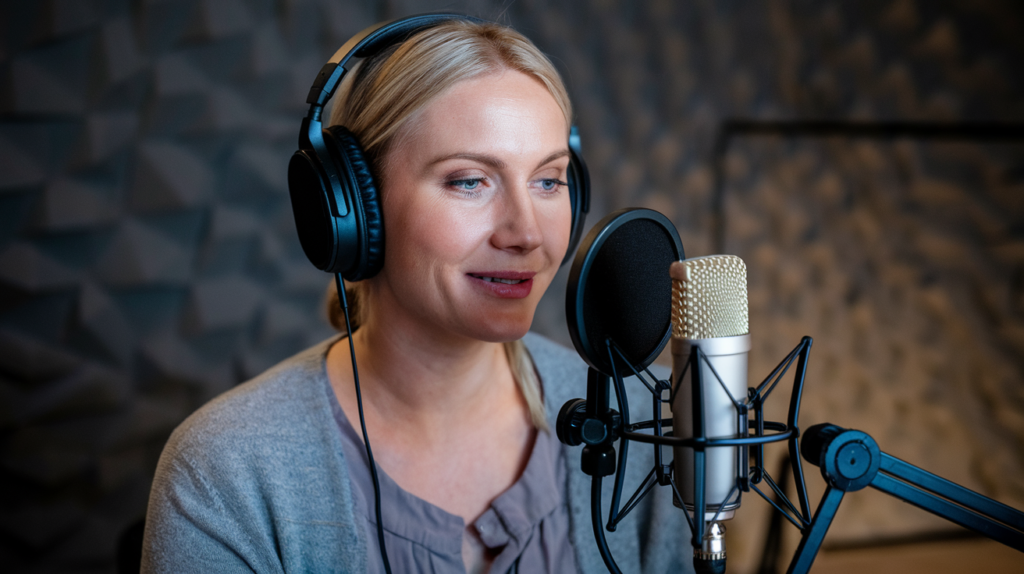Key Takeaways
- Phonetic Awareness: Understand the unique sounds and pronunciation variations of Australian English to enhance lip sync authenticity.
- Timing and Rhythm: Master precise timing to align mouth movements with audio cues, ensuring a seamless performance.
- Facial Expressions: Use appropriate facial expressions to convey emotions that match the spoken words, fostering relatability with your audience.
- Practice with Voiceovers: Regularly mimic professional voiceovers from Australian media to develop better rhythm and accent synchronization skills.
- Record and Analyze: Record your practice sessions to objectively assess areas for improvement in speed, pronunciation, and overall performance.
- Seek Feedback: Engage with peers or mentors familiar with Australian English accents for constructive criticism, helping you grow as a voice artist.
Ever wondered how to master lip sync techniques for Australian English? Whether you’re an aspiring actor, a content creator, or just someone looking to improve your skills, nailing that authentic Aussie accent while syncing your lips can be tricky.
Overview Of Lip Sync Techniques
Lip sync techniques are essential for conveying authentic emotion and character in performance, especially when working with Australian English. Understanding the nuances of this accent can elevate your acting or voiceover work significantly.
Key Techniques
- Phonetic Awareness: Familiarize yourself with the distinct sounds of Australian English. Pronunciation variations, such as vowel shifts and intonation patterns, play a crucial role in maintaining authenticity during lip syncing.
- Timing and Rhythm: Mastering timing is vital for effective lip sync. Align your mouth movements precisely with audio cues to create a seamless appearance that resonates with viewers.
- Facial Expressions: Use facial expressions to enhance your performance. Subtle changes convey emotions and reactions that complement the spoken words, making your portrayal more relatable.
- Practice with Voiceovers: Engage in exercises using existing voiceovers from Australian media sources. Mimicking professional voice artists helps develop an ear for rhythm and accents while improving synchronization skills.
- Recording Yourself: Record practice sessions to assess your progress objectively. Analyzing playback reveals areas needing improvement, whether it’s matching speed or refining pronunciation.
- Feedback and Iteration: Seek constructive feedback from peers or mentors familiar with Australian English accents. Incorporate their insights into future performances for continued growth as a voice actor or artist.
By focusing on these techniques, you can enhance your lip syncing abilities within the context of Australian English, leading to more engaging performances that resonate deeply with audiences.
Importance Of Lip Sync In Australian English
Lip sync plays a crucial role in delivering authentic performances in Australian English. It enhances engagement by aligning visual and auditory elements, allowing audiences to connect more deeply with the content. Mastering this technique can significantly elevate your skills as a voice artist or voice actor.
Cultural Relevance
Understanding the cultural nuances of Australian English is vital for effective lip syncing. The distinct sounds, slang, and expressions reflect Australia’s rich heritage. By accurately portraying these elements through lip movements, you convey authenticity that resonates with local audiences. This connection not only boosts relatability but also fosters trust between you and your viewers.
Practical Applications
Applying lip sync techniques in various contexts proves beneficial for voice talents across media platforms. Whether you’re involved in animated films, commercials, or educational videos, precise synchronization enhances clarity and professionalism. Practicing with authentic Australian voiceovers helps sharpen your skills while reinforcing proper timing and rhythm. Recording yourself offers valuable insights into how well you align visuals with audio cues—allowing room for improvement over time.
By honing your lip sync abilities specific to Australian English, you position yourself as a compelling choice for clients seeking engaging content that truly speaks to their audience.
Common Techniques Used
Mastering lip sync techniques specific to Australian English involves several key strategies that enhance your performance as a voice actor. Focusing on phonetic matching and timing can significantly improve the authenticity of your delivery.
Phonetic Matching
Phonetic matching is essential for achieving an authentic Aussie sound. Understanding the unique vowel shifts and consonant sounds in Australian English facilitates accurate synchronization between your lip movements and the audio. For instance, pay attention to how words like “mate” or “no worries” are pronounced differently compared to other English accents. Practicing with various voiceovers from Australian media helps you internalize these nuances, allowing for more natural expressions while lip syncing. Record yourself mimicking scenes from local shows or ads; this practice not only sharpens your skills but also builds confidence in using distinct phrases common to Australian culture.
Timing and Rhythm
Timing and rhythm play a crucial role in effective lip syncing. Aligning your mouth movements with the audio cues requires precision, especially when dealing with fast-paced dialogue or emotional scenes. Break down scripts into manageable sections, focusing on key moments where emotional expression aligns with vocal delivery. Use metronomes or rhythmic exercises to strengthen your sense of timing; this technique enhances your ability to keep pace with varying speech patterns found in Australian English voiceovers. Incorporate facial expressions that mirror emotions conveyed through tone—this deepens audience connection by reinforcing what they hear with what they see.
By honing these techniques, you position yourself as a compelling choice for projects requiring authentic Australian English performances, enhancing both clarity and professionalism in every voiceover role you take on.
Challenges Faced
Lip sync techniques for Australian English present unique challenges. Understanding these hurdles helps you enhance your skills as a voice artist or voice actor.
Regional Variations
Australian English varies significantly across regions, making it hard to master an authentic accent. Different states feature distinct pronunciations and slang, impacting how you sync with audio. For instance, the way “mate” is pronounced in Queensland differs from its sound in New South Wales. This variation requires keen phonetic awareness to ensure accurate lip movements align with specific regional sounds. Familiarizing yourself with various accents and practicing them can improve your overall performance.
Common Misconceptions
Many believe that lip syncing only involves mimicking sounds without considering the emotional context behind them. However, successful voice over talent understands that conveying emotion through facial expressions is crucial for authenticity. Another misconception is that mastering one accent suffices; yet, versatility is critical in the competitive field of voice acting. Engaging with diverse characters and styles allows you to adapt your techniques effectively while maintaining clarity and professionalism in every project.
By recognizing these challenges, you’re better prepared to tackle them head-on and elevate your craft as a skilled voice over artist or actor.
Best Practices For Effective Lip Sync
Mastering lip sync techniques for Australian English requires dedication and practice. You’ll find that specific strategies enhance your performance, making it more authentic and engaging.
Training Resources
Utilize various resources to sharpen your skills. Online courses focused on voice acting can provide valuable insights into phonetic matching and timing. Websites dedicated to voiceover training often offer exercises tailored for different accents, including Australian English. Additionally, consider joining forums or communities where you can share experiences with fellow voice artists. Engaging in these networks allows you to learn from others who are also honing their craft.
Tools and Software
Leverage technology to improve your lip sync accuracy. Various software programs enable you to record and analyze your voiceovers against video clips. Look for tools that provide visual feedback on your mouth movements in relation to audio cues; this feature can drastically enhance your understanding of synchronization. Mobile apps designed for actors allow you to practice anywhere, ensuring consistent improvement even during busy schedules. By incorporating these tools into your routine, you’ll refine both your technique and confidence as a voice actor delivering authentic performances in Australian English.
Conclusion
Mastering lip sync techniques for Australian English is a rewarding journey that enhances your performance skills. By focusing on phonetic awareness timing and facial expressions you can create engaging and authentic portrayals.
Practice is essential whether you’re working with local media or utilizing technology to refine your technique. Engaging with community resources provides valuable feedback and insights that accelerate your growth.
Embrace the challenges of regional variations and slang as opportunities to deepen your understanding of the Aussie accent. With dedication and a commitment to continuous improvement you’ll position yourself as a standout voice artist ready for any project requiring genuine Australian English performances.
Frequently Asked Questions
What are lip sync techniques for Australian English?
Lip sync techniques for Australian English involve mastering phonetic awareness, timing, and rhythm to align mouth movements with audio cues. This includes understanding distinct sounds of the Aussie accent and practicing with local media to internalize unique pronunciations.
Why is phonetic awareness important in lip syncing?
Phonetic awareness helps actors accurately match their lip movements with specific sounds and pronunciations unique to Australian English. It enables them to deliver authentic performances that resonate with local audiences.
How can I practice lip syncing effectively?
Effective practice involves using voiceovers from Australian media, recording yourself for feedback, and aligning your mouth movements with audio cues. Engaging in dedicated training resources like online courses can also enhance skills.
What challenges exist in mastering lip sync for Australian English?
Challenges include regional variations in pronunciation, slang usage, and ensuring emotional expression through facial movements. Actors must be aware of these nuances to achieve authentic performances tailored to specific audiences.
How can technology aid my lip sync practice?
Leveraging technology such as software for recording and analyzing voiceovers against video clips can significantly improve your technique. Mobile apps also provide convenient options for on-the-go practice to refine skills consistently.
Is feedback important in developing lip sync skills?
Yes, seeking feedback from peers or mentors is crucial for growth as a voice actor. Constructive criticism helps identify areas needing improvement while fostering confidence in delivering authentic performances.







